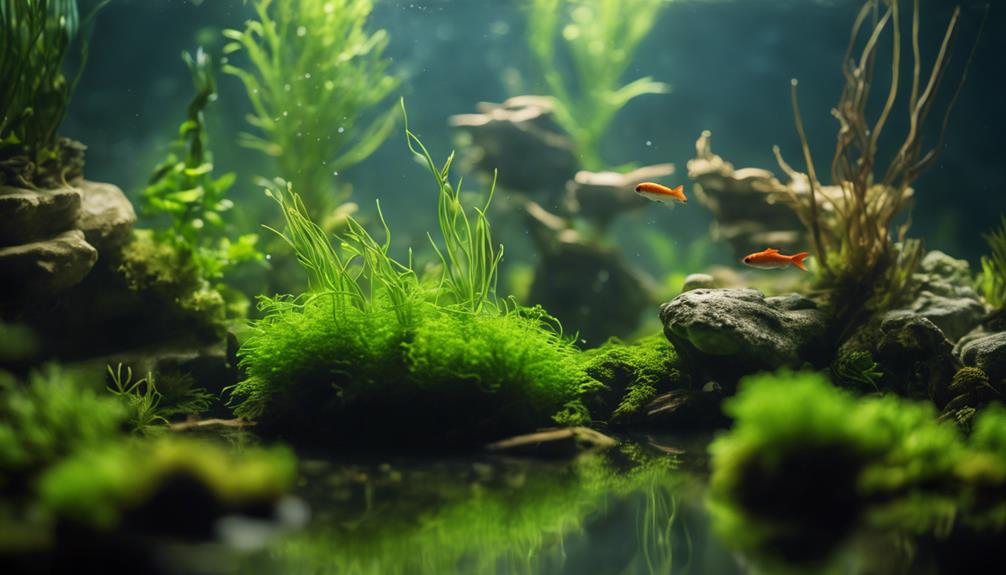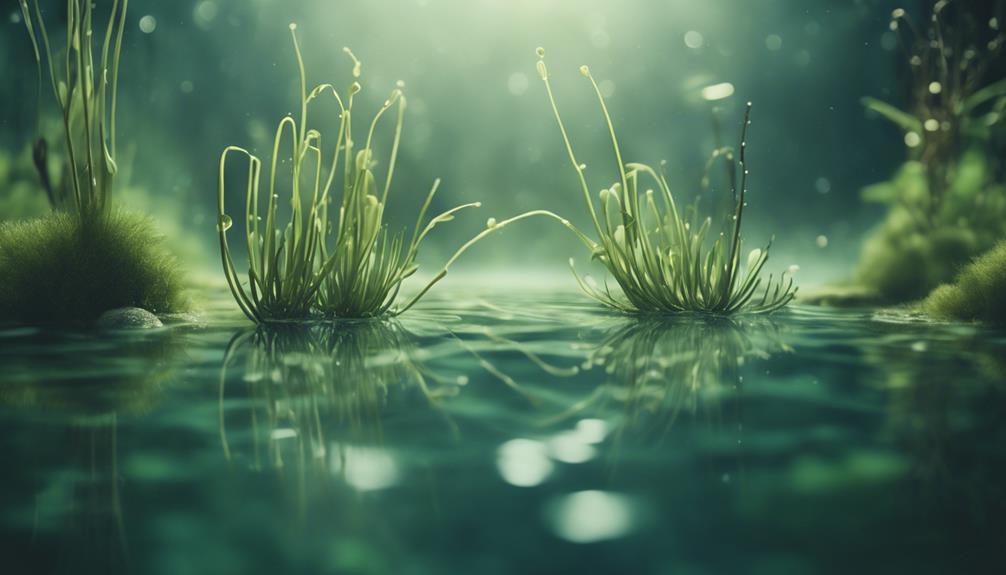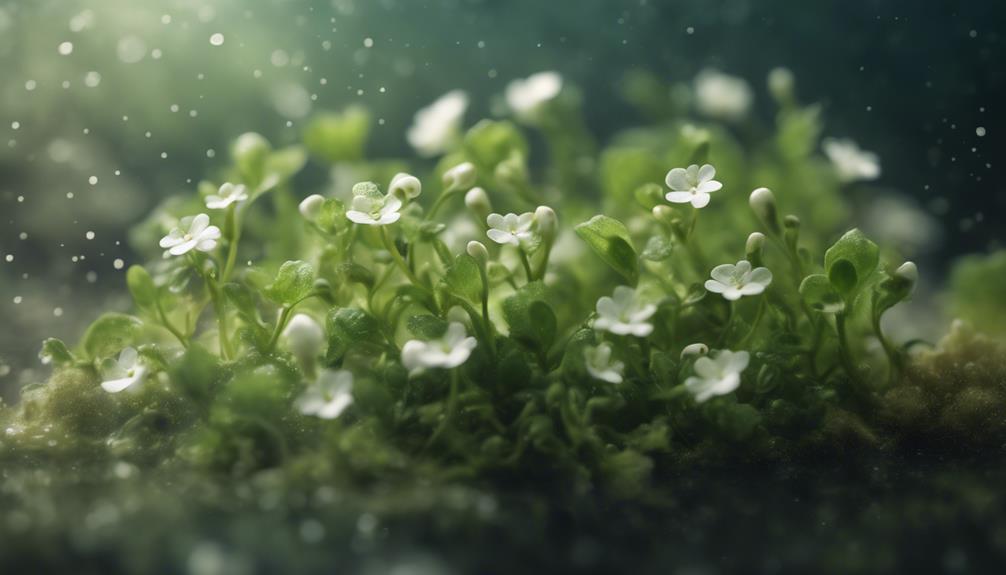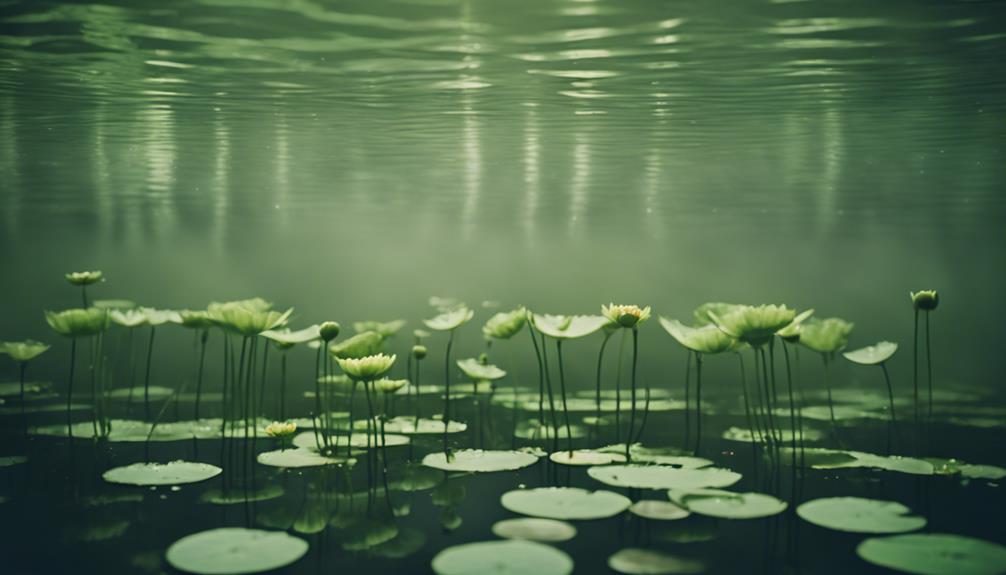You're likely unaware that certain aquatic plants possess inherent traits that enable them to outcompete algae for resources, absorb excess nutrients, and create a natural barrier against algae growth. Seven effective plants for combating algae growth include Salvinia Natans, Red Root Floaters, Java Moss, Rotala Narrow Leaf Sp, Egeria Densa, Hygrophila Difformis, and Bacopa Caroliniana. Each of these plants features unique characteristics, such as rapid growth rates, nutrient absorption, and allelopathic compounds, making them effective natural solutions to algae growth. By understanding how these plants work, you'll be able to tap into the secrets to a thriving, algae-free aquatic environment.
Table of Contents
Key Takeaways
- Algae-combating plants outcompete algae for resources, absorbing excess nutrients and toxic compounds to promote a balanced environment.
- These plants create a natural barrier against algae growth, reducing the need for chemical treatments and improving water clarity.
- By absorbing carbon dioxide and producing oxygen, algae-combating plants improve water quality and create a thriving ecosystem.
- Plants like Salvinia Natans, Red Root Floaters, and Java Moss are effective at combating algae growth due to their fast-growing and competitive nature.
- Using algae-combating plants provides a natural and effective solution to algae growth, maintaining a balanced environment where aquatic life flourishes.
Combating Algae With Salvinia Natans
When introducing Salvinia Natans to your aquarium, you're effectively deploying a natural, highly effective countermeasure against algae growth, as this fast-growing floating fern rapidly forms dense mats on the water's surface, thereby blocking out light penetration and absorbing excess nutrients.
By doing so, you're creating a balanced environment in your aquatic space, where algae struggles to thrive.
This plant species is an effective natural solution for combating algae, as it outcompetes algae for essential nutrients and prevents their growth.
The unique nickel-sized leaves of Salvinia Natans, with their fuzzy texture, enable the plant to absorb excess nutrients and toxic compounds from the water, further contributing to a healthy and balanced aquatic environment.
As a result, you can enjoy a thriving ecosystem, where your aquatic life flourishes, and algae growth is kept under control.
Red Root Floaters for Algae Control
As you explore the benefits of Red Root Floaters for algae control, you'll want to understand how to optimize their growth and care.
By providing the right conditions, you can encourage these floating plants to thrive and effectively combat algae growth.
Benefits of Red Root
By incorporating Red Root Floaters into your aquarium, you can harness the power of these beneficial plants to combat algae growth and create a balanced, thriving environment.
As a popular floating plant species, Red Root Floaters feature blood-red roots and undersides, propagating quickly and creating a dense canopy on the water's surface. This shading effect deprives algae of light, slowing its growth rate.
In addition, Red Root Floaters absorb excess nutrients and toxic compounds from the water, promoting a balanced environment in the aquarium and reducing the risk of algae growth. Their rapid growth rate and ability to outcompete algae for resources make them an effective natural solution for controlling algae in aquatic environments.
With their versatility in thriving in various water conditions, including low-light and high-light settings, Red Root Floaters are a great addition to any aquarium. As a low-maintenance plant, they require minimal care, making them an easy and effective means of algae control.
Floating Plant Care
You can successfully cultivate Red Root Floaters for algae control by maintaining ideal water conditions and performing regular pruning to promote healthy growth and prevent overcrowding.
To thrive, these floating plants require a water temperature between 65-85°F (18-29°C) and pH levels between 6.5-8.5. They can tolerate moderate to high lighting, making them versatile for various aquatic environments.
As they absorb excess nutrients from the water column, they deprive algae of the resources needed to grow. Regular pruning is essential to prevent overcrowding, which can lead to oxygen depletion and create an environment conducive to algae growth.
By pruning, you'll encourage plant growth and maintain a dense canopy on the water's surface, blocking out light penetration and preventing algae growth. With proper care, Red Root Floaters will propagate quickly, producing new plants from their roots.
Java Moss: A Natural Algae Fighter

One of the most effective natural algae fighters in the aquatic world is Java Moss, a low-maintenance, versatile, and easy-to-care-for plant that flourishes without the need for CO2 supplementation or high-intensity lighting. As an aquarist, you can rely on Java Moss to improve water quality by absorbing carbon dioxide and producing oxygen, creating a healthy environment for your aquatic life.
| Benefits | How Java Moss Achieves It |
|---|---|
| Improves Water Quality | Absorbs carbon dioxide and produces oxygen |
| Reduces Algae Growth | Outcompetes algae for resources, absorbs excess nutrients and toxic compounds |
| Maintains Balanced Ecosystem | Provides shade, competes for essential nutrients like nitrogen and phosphorus |
Java Moss grows rapidly, making it an ideal choice for maintaining a balanced ecosystem. Its dense, carpet-like growth habit provides shade, making it harder for algae to thrive in well-lit areas, and competes for essential nutrients like nitrogen and phosphorus, leaving less for algae. With Java Moss, you can create a thriving aquatic environment that's free from excessive algae growth.
Rotala Narrow Leaf Sp: Algae Solution
As you explore the benefits of Rotala Narrow Leaf Sp in controlling algae growth, you'll discover its unique properties that make it an effective solution.
Its fast-growing stems and vibrant red foliage outcompete algae for essential resources, maintaining a balanced environment and promoting water quality.
Rotala's Algae-Fighting Properties
Rotala Narrow Leaf Sp.'s exceptional capacity to absorb excess nutrients from the water column makes it an effective natural solution for combating algae growth in aquariums.
As you introduce this fast-growing stem plant into your aquatic environment, it will rapidly absorb nitrate and phosphate, depriving algae of the resources they need to thrive. This process not only improves water quality but also helps maintain a balanced ecosystem.
With a growth rate of 1-2 inches per week, Rotala Narrow Leaf Sp. becomes a strong competitor against algae for light and nutrients, allowing your aquatic plants to flourish.
As a submerged plant, it excels at absorbing ammonia and nitrite, further enhancing water clarity.
By incorporating Rotala Narrow Leaf Sp. into your aquarium, you'll create a natural barrier against algae growth, reducing the need for chemical treatments and promoting a thriving environment.
With its vibrant red foliage and narrow leaves, this plant species adds a pop of color to your underwater landscape while providing a scientifically-backed solution to algae control.
Narrow Leaf Benefits
By incorporating Rotala Narrow Leaf Sp. into your aquarium, you'll reap a multitude of benefits that not only combat algae growth but also enhance the overall health and aesthetic appeal of your underwater environment.
As a fast-growing stem plant, Rotala Narrow Leaf Sp. competes with algae for light and nutrients, helping to maintain water quality by absorbing excess nutrients and promoting a balanced environment.
Its narrow leaves and compact growth habit make it an excellent choice for creating a natural-looking aquascape, and it can be paired with other plants to create a visually appealing and diverse aquarium environment.
With its easy care and adaptability to various lighting conditions, Rotala Narrow Leaf Sp. is an ideal choice for both beginners and experienced aquarists.
By regularly pruning this plant, you can maintain a desired shape and promote healthy growth, while also supporting algae control.
As a natural solution to algae growth, Rotala Narrow Leaf Sp. is an effective way to enhance the natural beauty of your aquarium while maintaining superior water quality.
Egeria Densa: A Fast-Growing Ally

You can combat algae growth by introducing Egeria Densa, a fast-growing, highly competitive plant that effectively absorbs excess nutrients from the water column.
This aquatic plant is a valuable addition to your planted aquarium, as it deprives algae of the resources they need to grow, promoting a balanced environment.
Egeria Densa grows rapidly, up to 1-2 inches a week, making it an effective competitor against algae for light and nutrients in the water.
Its versatility allows it to thrive in a wide range of water conditions, from low to high light, and from soft to hard water.
Regular pruning is necessary to maintain the plant's health and promote its rapid growth.
By absorbing ammonia and nitrite, Egeria Densa also improves water quality, creating a healthier environment for your aquatic life.
By incorporating Egeria Densa into your planted aquarium, you'll be taking a significant step towards reducing algae growth and maintaining a balanced ecosystem.
With its fast-growing nature and nutrient-absorbing capabilities, this plant is an excellent ally in the fight against algae.
Hygrophila Difformis: Effective Algae Combatant
One of the most effective plants in combating algae growth is Hygrophila Difformis, a fast-growing species that can outcompete algae for resources and thrive in a wide range of water conditions.
As an aquatic plant enthusiast, you'll appreciate its ability to absorb excess nutrients from the water column, depriving algae of the resources it needs to grow and thrive.
This hardy plant can tolerate soft to hard water and temperatures between 72-82°F (22-28°C), making it an ideal choice for creating a balanced pond or aquarium.
With a growth rate of up to 1-2 inches per week, Hygrophila Difformis can quickly establish itself as a dominant force in your aquatic environment.
As a beginner-friendly plant, it's relatively easy to care for and can tolerate some neglect.
By incorporating Hygrophila Difformis into your aquatic plants, you'll be taking a significant step towards improving water quality and reducing algae growth.
Bacopa Caroliniana: Natural Algae Inhibitor

In addition to Hygrophila Difformis, another aquatic plant that excels at suppressing algae growth is Bacopa Caroliniana, which rapidly outcompetes algae for nutrients and absorbs excess ammonia and nitrite from the water column. As you consider using Bacopa Caroliniana for algae control, you must understand its growth requirements and benefits.
| Characteristics | Description |
|---|---|
| Lighting Conditions | Moderate to high lighting |
| Growth Rate | Up to 2-3 inches per week |
| Propagation | Easy to propagate and care for |
| Allelopathic Compounds | Inhibits algae and unwanted plant growth |
Frequently Asked Questions
What Plants Are Good for Removing Algae?
You're looking for effective algae removers? Try deploying Algae Fighters like Pickerelweed, Willow Moss, or Hornwort, which serve as Pond Plants, Water Purifiers, and Nature's Filters, leveraging their Bio Controls to create a balanced ecosystem, earning them the title of Eco Warriors and Fresh Saviors for Lake Lovers.
How Do You Naturally Reduce Algae?
You optimize water conditions by balancing pH levels, increasing oxygen through aeration and circulation, and regulating flow rates, while also utilizing UV treatment, sediment removal, and sunlight exposure to naturally reduce algae growth.
How to Get Plants to Outcompete Algae?
You optimize plant growth by ensuring ideal lighting, nutrient balance, and soil quality, while promoting water circulation, dense planting, and strategic species selection to foster healthy root development, microbe interaction, and a competitive advantage over algae.
Is There a Plant That Eats Algae?
As you search for a plant that eats algae, you'll discover Algae Fighters like none, but you'll find Plant Predators, Algae Assassins, and Nature's Filters that outcompete algae, making them your Water Wizards, Green Guardians, Eco Warriors, Pond Police, and Lake Lovers.
Conclusion
As you've ventured into the world of aquatic plant life, you've discovered a treasure trove of natural allies in the fight against algae.
Like a finely-tuned orchestra, each of these 7 plants plays its unique role in creating a harmonious balance, stifling the pesky growth of algae.
With their combined forces, your aquarium's crystal-clear waters will shine like a beacon, unblemished by the unsightly green haze of algae.

